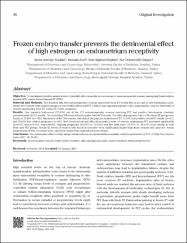| dc.contributor.author | Erşahin, Aynur Adeviye | |
| dc.contributor.author | Acet, Mustafa | |
| dc.contributor.author | Erşahin, Suat Süphan | |
| dc.contributor.author | Dokuzeylül Güngör, Nur | |
| dc.date.accessioned | 10.07.201910:49:13 | |
| dc.date.accessioned | 2019-07-10T20:01:33Z | |
| dc.date.available | 10.07.201910:49:13 | |
| dc.date.available | 2019-07-10T20:01:33Z | |
| dc.date.issued | 2017 | en_US |
| dc.identifier.citation | Erşahin, A. A., Acet, M., Erşahin, S. S. ve Dokuzeylül Güngör, N. (2017). Frozen embryo transfer prevents the detrimental effect of high estrogen on endometrium receptivity. Journal of the Turkish-German Gynecological Association, 18(1), 38-42. https://dx.doi.org/10.4274/jtgga.2016.0186 | en_US |
| dc.identifier.issn | 1309-0399 | |
| dc.identifier.issn | 1309-0380 | |
| dc.identifier.uri | https://dx.doi.org/10.4274/jtgga.2016.0186 | |
| dc.identifier.uri | https://hdl.handle.net/20.500.12511/3335 | |
| dc.description | WOS: 000398542000008 | en_US |
| dc.description | PubMed ID: 28506949 | en_US |
| dc.description.abstract | Objective: To investigate whether serum levels of estradiol affect reproductive outcomes of normoresponder women undergoing fresh embryo transfer (ET) versus frozen-thawed ET (FET). Material and Methods: Two hundred fifty-five normoresponder women underwent fresh ET in their first or second in vitro fertilization cycle. Ninety-two women with negative pregnacy test results underwent FET. Clinical and ongoing pregnancy rates, implantation, and live birth rates of women undergoing fresh ET versus FET were compared. Results: One hundred forty-seven (57.65%) out of the 255 normoresponder women receiving FET had positive beta-human chorionic gonadotrophin (hCG) results. The remaining 108 women had negative beta-hCG results. The clinical pregnancy rates of the fresh ET group were found as 55.69% (n=142). Ninety-two of the 108 women with failed pregnancies underwent FET; 72.83% had positive beta-hCG results (n=67), and 70.65% had clinical pregnancy (n=65). Both biochemical and clinical pregnancy rates of women undergoing FET increased significantly (p<0.012 and p<0.013, respectively). Ongoing pregnancy (60.87% vs. 52.94%) and live birth rates (59.87% vs. 48.63%) were similar in both fresh and FET groups. Serum E2 levels of women who failed to conceive were significantly higher than those women did conceive. Serum progesterone levels of women who conceived versus those that did not were similar. Conclusion: The detrimental effect of high serum estradiol levels on endometrial receptivity could be prevented by FET. | en_US |
| dc.language.iso | eng | en_US |
| dc.publisher | Galenos Yayıncılık | en_US |
| dc.rights | info:eu-repo/semantics/openAccess | en_US |
| dc.subject | Frozen Embryo Transfer | en_US |
| dc.subject | Fresh Embryo Transfer | en_US |
| dc.subject | Clinical Pregnancy Rates | en_US |
| dc.subject | Serum Estradiol | en_US |
| dc.subject | Serum Progesterone | en_US |
| dc.title | Frozen embryo transfer prevents the detrimental effect of high estrogen on endometrium receptivity | en_US |
| dc.type | article | en_US |
| dc.relation.ispartof | Journal of the Turkish-German Gynecological Association | en_US |
| dc.department | İstanbul Medipol Üniversitesi, Tıp Fakültesi, Cerrahi Tıp Bilimleri Bölümü, Kadın Hastalıkları ve Doğum Ana Bilim Dalı | en_US |
| dc.identifier.volume | 18 | en_US |
| dc.identifier.issue | 1 | en_US |
| dc.identifier.startpage | 38 | en_US |
| dc.identifier.endpage | 42 | en_US |
| dc.relation.publicationcategory | Makale - Uluslararası Hakemli Dergi - Kurum Öğretim Elemanı | en_US |
| dc.identifier.doi | 10.4274/jtgga.2016.0186 | en_US |
| dc.identifier.scopusquality | Q3 | en_US |


















